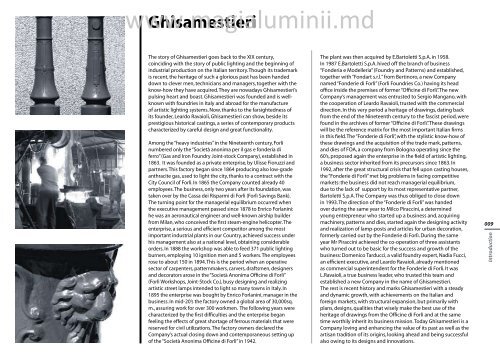IP66 - Magia Luminii
IP66 - Magia Luminii
IP66 - Magia Luminii
Create successful ePaper yourself
Turn your PDF publications into a flip-book with our unique Google optimized e-Paper software.
www.magialuminii.md<br />
Ghisamestieri<br />
The story of Ghisamestieri goes back to the XIX century,<br />
coinciding with the story of public lighting and the beginning of<br />
industrial production on the Italian territory. Though its trademark<br />
is recent, the heritage of such a glorious past has been handed<br />
down to clever men, technicians and managers, together with the<br />
know-how they have acquired. They are nowadays Ghisamestieri’s<br />
pulsing heart and boast. Ghisamestieri was founded and is wellknown<br />
with foundries in Italy and abroad for the manufacture<br />
of artistic lighting systems. Now, thanks to the farsightedness of<br />
its founder, Leardo Ravaioli, Ghisamestieri can show, beside its<br />
prestigious historical castings, a series of contemporary products<br />
characterized by careful design and great functionality.<br />
Among the “heavy industries” in the Nineteenth century, Forlì<br />
numbered only the “Società anonima per il gas e fonderia di<br />
ferro” (Gas and Iron Foundry Joint-stock Company), established in<br />
1863. It was founded as a private enterprise, by Ulisse Fioruzzi and<br />
partners. This factory began since 1864 producing also low-grade<br />
anthracite gas, used to light the city, thanks to a contract with the<br />
City Council of Forlì. In 1865 the Company counted already 40<br />
employees. The business, only two years after its foundation, was<br />
taken over by the Cassa dei Risparmi di Forlì (Forlì Savings Bank).<br />
The turning point for the managerial equilibrium occurred when<br />
the executive management passed since 1878 to Enrico Forlanini:<br />
he was an aeronautical engineer and well-known airship builder<br />
from Milan, who conceived the first steam-engine helicopter. The<br />
enterprise, a serious and efficient competitor among the most<br />
important industrial plants in our Country, achieved success under<br />
his management also at a national level, obtaining considerable<br />
orders. In 1888 the workshop was able to feed 371 public lighting<br />
burners, employing 10 ignition men and 5 workers. The employees<br />
rose to about 150 in 1894. This is the period when an operative<br />
sector of carpenters, patternmakers, carvers, draftsmen, designers<br />
and decorators arose in the “Società Anonima Officine di Forlì”<br />
(Forlì Workshops, Joint-Stock Co.), busy designing and realizing<br />
artistic street lamps intended to light so many towns in Italy. In<br />
1895 the enterprise was bought by Enrico Forlanini, manager in the<br />
business. In mid-20’s the factory owned a global area of 30,000sq.<br />
m., assuring work for over 300 workmen. The following years were<br />
characterized by the first difficulties and the enterprise began<br />
feeling the effects of great shortage of ferrous materials that were<br />
reserved for civil utilizations. The factory owners declared the<br />
Company’s actual closing down and contemporaneous setting up<br />
of the “Società Anonima Officine di Forlì” in 1942.<br />
The plant was then acquired by E.Bartoletti S.p.A. in 1958.<br />
In 1987 E.Bartoletti S.p.A. hived off the branch of business<br />
“Fonderia e Modelleria” (Foundry and Patterns) and established,<br />
together with “Fondart s.r.l.” from Bertinoro, a new Company<br />
named “Fonderie di Forlì” (Forlì Foundries Co.) having its head<br />
office inside the premises of former “Officine di Forlì”. The new<br />
Company’s management was entrusted to Sergio Mangano, with<br />
the cooperation of Leardo Ravaioli, trusted with the commercial<br />
direction. In this very period a heritage of drawings, dating back<br />
from the end of the Nineteenth century to the fascist period, were<br />
found in the archives of former “Officine di Forlì”. These drawings<br />
will be the reference matrix for the most important Italian firms<br />
in this field. The “Fonderie di Forlì”, with the stylistic know-how of<br />
these drawings and the acquisition of the trade mark, patterns,<br />
and dies of FOA, a company from Bologna operating since the<br />
60’s, proposed again the enterprise in the field of artistic lighting,<br />
a business sector inherited from its precursors since 1863. In<br />
1992, after the great structural crisis that fell upon casting houses,<br />
the “Fonderie di Forlì” met big problems in facing competitive<br />
markets: the business did not reach managerial equilibrium,<br />
due to the lack of support by its most representative partner,<br />
Bartoletti S.p.A. The Company was thus obliged to close down<br />
in 1993. The direction of the “Fonderie di Forlì” was handed<br />
over during the same year to Milco Piraccini, a determined<br />
young entrepreneur who started up a business and, acquiring<br />
machinery, patterns and dies, started again the designing activity<br />
and realization of lamp-posts and articles for urban decoration,<br />
formerly carried out by the Fonderie di Forlì. During the same<br />
year Mr Piraccini achieved the co-operation of three assistants<br />
who turned out to be basic for the success and growth of the<br />
business: Domenico Tarducci, a valid foundry expert, Nadia Fucci,<br />
an efficient executive, and Leardo Ravaioli, already mentioned<br />
as commercial superintendent for the Fonderie di Forlì. It was<br />
L.Ravaioli, a true business leader, who trusted this team and<br />
established a new Company in the name of Ghisamestieri.<br />
The rest is recent history and marks Ghisamestieri with a steady<br />
and dynamic growth, with achievements on the Italian and<br />
foreign markets, with structural expansion, but primarily with<br />
plans, designs, qualities that wisely make the best use of the<br />
heritage of drawings from the Officine di Forlì and at the same<br />
time worthily inherit its business mission. Today Ghisamestieri is a<br />
Company loving and enhancing the value of its past as well as the<br />
artisan tradition of its origins, looking ahead and being successful<br />
also owing to its designs and innovations.<br />
009<br />
Introduction




